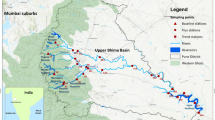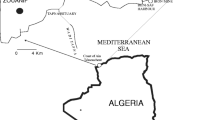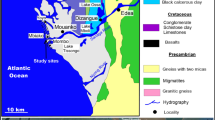Abstract
Bauxite and iron ore mining is the major contributor to metal pollution in Tasik Chini, Malaysia. Deforestation of the protected zone of reserve forest exacerbates the problem. The current study is to understand the speciation of metals spatially in sediment to analyse the risk associated in terms of its mobility and bioavailability. The samples of sediment are collected from Sungai Jemberau, Laut Jemberau, and Laut Gumum of Tasik Chini. Four samplings were conducted for a year, by collecting the surface sediment. Sequential extraction method was followed for speciation of sediment and classified it into exchangeable, reducible, Fe–Mn oxides, organic and residual fractions. The results were also analyzed using principal component analysis (PCA) and cluster analysis (CA). The result reveals that Fe, Al, Mn, Zn, and Pb are the primary constituents of sediment contributing to about 98% of residual fraction. Co, Cd, Cr, As, and Ni are found in trace metal concentration and are identified to be mainly released from anthropogenic sources nearby. Although the individual proportion is less than major metals in exchangeable and carbonate fraction, they possess geochemically significant concentration above the permissible limit. More than 70–80% of all its total concentration proportion is hence found in mobile and bioavailable state. These possess toxic and have chronic effects to aquatic life and public health even in trace elemental concentration. Hence, these metals are the most toxic and bioavailable metals pausing risk for aquatic and public health. PCA analysis highlights that the enrichment of heavy metals in bioavailable fraction is mostly contributed from anthropogenic sources. The same results are emphasized by cluster analysis.









Similar content being viewed by others
References
Ahmad A, Othman M (2010) Heavy Metal concentration in sediments and fishes from Lake Chini, Pahang. Malaysia. J Biol Sci 10(2):93–100
Ahmad AK, Othman MS, Mushrifah I (2008) The heavy metals temporal variability in fish of Tasik Chini, Peninsular Malaysia. Proceedings of Taal 2007: The 12th World Lake Conference. 2131-2135
Anderberg MR (2014) Cluster analysis for applications: probability and mathematical statistics: a series of monographs and textbooks. Academic Press, p 19
Arenas-Lago D, Andrade ML, Lago-Vila M, Rodríguez-Seijo A, Vega FA (2014) Sequential extraction of heavy metals in soils from a copper mine: distribution in geochemical fractions. Geoderma 230:108–118
Arnason JG, Fletcher BA (2003) A 40+ year record of Cd, Hg, Pb and U deposition in sediments of Patroon Reservoir, Albany County, NY, USA. Environ Pollut 123:383–391
Ashraf MA, Maah MJ, Yusoff I (2012) Chemical speciation and potential mobility of heavy metals in the soil of former tin mining catchment. Sci World J 2012:1–11
Davutluoglu OI, Seckın G, Kalat DG, Yılmaz T, Ersu CB (2010) Speciation and ımplications of heavy metal content in surface sediments of Akyatan Lagoon–Turkey. Desalination 260(1):199–210
Duruibe JO, Ogwuegbu MOC, Egwurugwu JN (2007) Heavy metal pollution and human biotoxic effects. Int J Phys Sci 2(5):112–118
Ebrahimpour M, Idris M (2008) Heavy metal concentrations in water and sediments in Tasik Chini, a freshwater lake, Malaysia. Environ Monit Assess 141(3):297–307
EPA (2011) Increase in cancers and fertility problems may be caused by household chemicals and pharmaceuticals. EPA
Ferronato C (2013) Speciation of heavy metals at water-sediment interface. EQA Int J Environ Qual 10(10):51–64
Hong YS, Kerry AK, Danny DR (2011) Effects of cyclic changes in pH and salinity on metals release from sediments. Environ Toxicol Chem 30(8):1775–1784
Ikem A, Egiebor NO, Nyavor K (2003) Trace elements in water, fish, and sediment from Tuskegee Lake, Southeastern USA. Water Air Soil Pollut 149:51–75
Islam MS, Ahmed MK, Raknuzzaman M, Habibullah-Al-Mamun M, Islam MK (2015) Heavy metal pollution in surface water and sediment: a preliminary assessment of an urban river in a developing country. Ecol Indic 1(48):282–291
Gasim MB, Toriman ME, Abas A, Islam MS, Chek TC (2008) Water quality of several feeder rivers between two seasons in Tasik Chini, Pahang. Sains Malays. 37(4):313–321
Li H, Shi A, Li M, Zhang X (2013) Effect of pH, temperature, dissolved oxygen, and flow rate of overlying water on heavy metals release from storm sewer sediments. J Chem 2013:1–11
Low KH, Koki IB, Juahir H, Azid A, Behkami S, Ikram R (2016) Evaluation of water quality variation in lakes, rivers, and ex-mining ponds in Malaysia (review). Desalin Water Treat 57(58):28215–28239
Mason RP (2013) Trace metals in aquatic systems. Wiley-Blackwell, Chichester
Moritsuka N, Matsuoka K, Katsura K, Sano S, Yanai J (2014) Soil color analysis for statistically estimating total carbon, total nitrogen and active iron contents in Japanese agricultural soils. J Soil Sci Plant Nutr 60(4):475–485
Morrison GMP (2011) Urban storm water pollution- heavy metal speciation studies of natural waters: a review. Chalmers tekniska hogskola. Goteborg 2:84.
Olsen RL, Rick WC, Jim CL (2012) Water quality sample collection, data treatment and results presentation for principal components analysis–literature review and Illinois River watershed case study. Water Res 46(9):3110–3122
Passos EA, Alves JPH, Garcia CAB, Costa ACS (2011) Metal fractionation in sediments of the Sergipe River, northeast Brazil. J Braz Chem Soc 22
Pokhrel LR, Dubey B (2013) Global scenarios of metal mining, environmental repercussions, public policies, and sustainability: a review. Crit Rev Environ Sci Technol 43(21):2352–2388. https://doi.org/10.1080/10643389.2012.672086
Reyhani P, Reza AM (2013) Assessment of heavy metals contamination in surface water of the upstream Sardabrud River, North Iran. Life Sci 10(7):884–892
Roberts D, Maarten N, Donald LS (2005) Speciation of metals in soils. Soil Sci Soc Am J 8:619–654
Saleem M, Iqbal J, Shah MH (2015) Geochemical speciation, anthropogenic contamination, risk assessment and source identification of selected metals in freshwater sediments – a case study from Mangla Lake, Pakistan. Environ Nanotechnol Monit Manag 4:27–36. https://doi.org/10.1016/j.enmm.2015.02.002
Saraçli S, Nurhan D, İsmet D (2013) Comparison of hierarchical cluster analysis methods by cophenetic correlation. J Inequal Appl 2013(1):203
Sharip Z, Jusoh J (2010) Integrated lake basin management and its importance for Lake Chini and other lakes in Malaysia. Lakes Reserv Res Manag 15:41–51
Smith L (2002) A tutorial on principal components analysis. Cornell University, USA. 51(52): 65
Soosal V, Sivalingam A (2011) Tasik Chini - a national heritage in Peril. Transp Int Malaysia 22(2):1–2
Sundaray SK (2011) Geochemical speciation and risk assessment of heavy metals in the river estuarine sediments—a case study: Mahanadi basin, India. J Hazard Mater 186(2):1837–1846
Tessier A, Campbell PG, Bisson M (1979) Sequential extraction procedure for the speciation of particulate trace metals. Anal Chem 51(7):844–851
Toriman ME, Kamarudin MKA, Idris M, Jamil NR, Gazim MB, Aziz NAA (2009) Sediment concentration and load analyses at Chini River, Pekan, Pahang, Malaysia. EESRJ 1(2):43–50
Vogel-Mikuš K, Damjana D, Marjana R (2005) Zn, Cd and Pb accumulation and arbuscular mycorrhizal colonization of pennycress Thlaspi praecox Wulf. (Brassicaceae) from the vicinity of a lead mine and smelter in Slovenia. Environ Pollut 133(2):233–242
Wuana RA, Okieimen FE (2011) Heavy metals in contaminated soils: a review of sources, chemistry, risks and best available strategies for remediation. ISRN Ecol 2011:1–20
Xiong Y, Zhu F, Zhao L, Zhang Z (2014) Heavy metal speciation in various types of fly ash from municipal solid waste incinerator. J Mater Cycles Waste J 16(4):608–615
Yuan C, Shi J, Liu HB, Liu J, Liang L, Jiang G (2004) Speciation of heavy metals in marine sediments from the East China Sea by ICP-MS with sequential extraction. Environ Int 30:769–783
Zhu H, Yuan X, Zeng G, Jiang M, Liang J, Zhang C, Yin J, Liu Z, Jiang H (2012) Ecological risk assessment of heavy metals in sediments of Xiawan Port based on modified potential ecological risk index. Trans Nonferrous Metals Soc China 22:1470–1477
Zimmerman AJ, Weindorf DC (2010) Heavy metal and trace metal analysis in soil by sequential extraction: a review of procedures. Int J Anal Chem 2010:1–7
Author information
Authors and Affiliations
Corresponding author
Additional information
Responsible editor: Philippe Garrigues
Publisher’s note
Springer Nature remains neutral with regard to jurisdictional claims in published maps and institutional affiliations.
Rights and permissions
About this article
Cite this article
Krishnankutty, N., Idris, M., Hamzah, F.M. et al. The chemical form and spatial variation of metals from sediment of Jemberau mining region of Tasik Chini, Malaysia. Environ Sci Pollut Res 26, 25046–25056 (2019). https://doi.org/10.1007/s11356-019-05680-3
Received:
Accepted:
Published:
Issue Date:
DOI: https://doi.org/10.1007/s11356-019-05680-3




